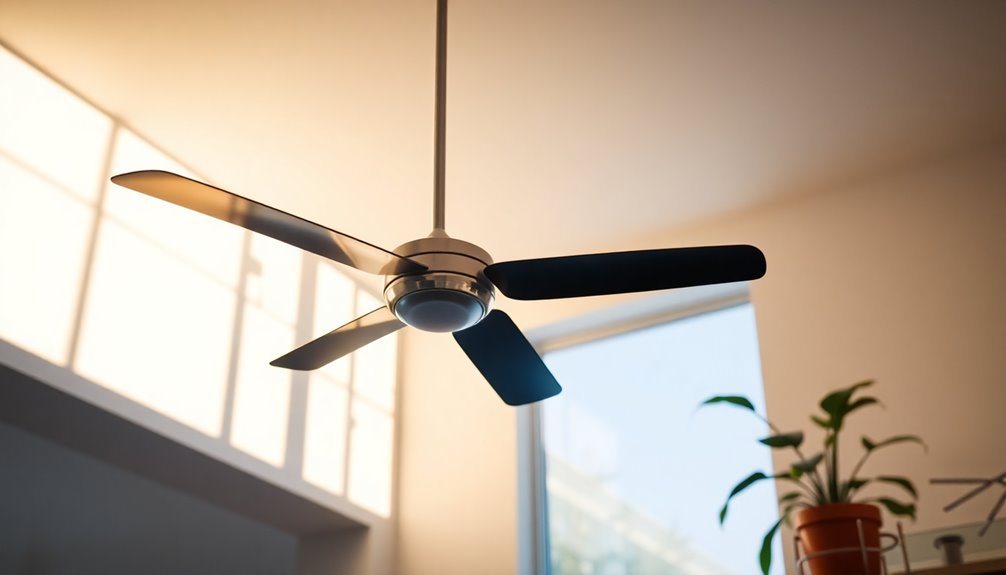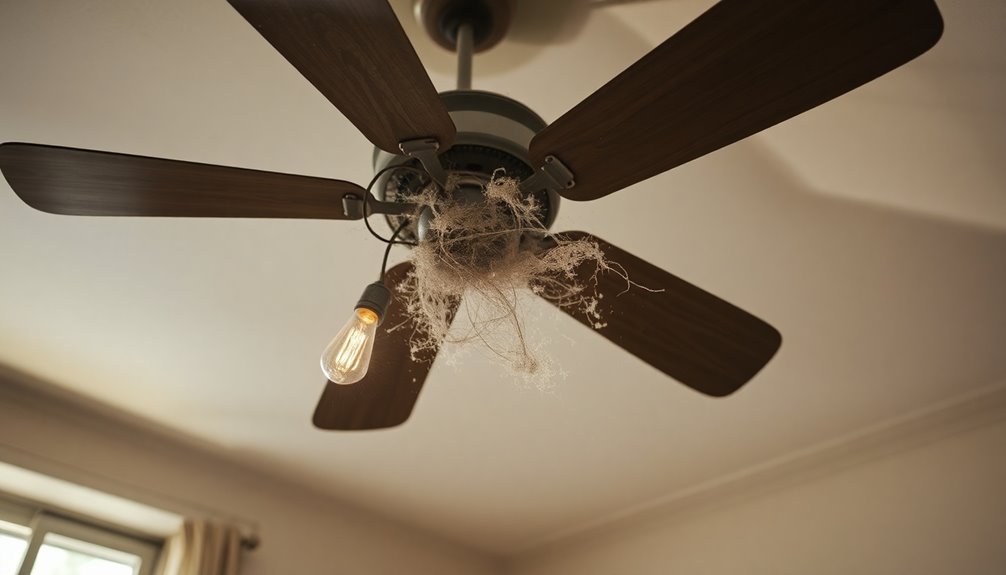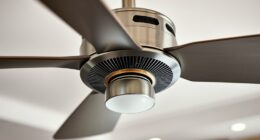You should install your ceiling fan 7 to 9 feet above the floor for ideal airflow and safety. If your ceiling is 8 feet high, hang the fan down about 10 inches, placing the blades at 8 feet. For higher ceilings, position the blades 9 to 12 feet above the floor. It's essential that the blades are at least 7 feet from the ground to avoid injury. Also, keep the fan at least 18 inches away from walls for proper circulation. There's more to reflect on when finding the perfect fit for your space, so keep exploring your options!
Key Takeaways
- Ceiling fans should be installed 7 to 9 feet above the floor for optimal safety and airflow efficiency.
- For 8-foot ceilings, hang the fan down 10 inches, ensuring blades are at 8 feet.
- Fans must have blades at least 7 feet from the floor, increasing to 7 feet 6 inches above pools.
- When installing in higher ceilings, calculate downrod length by subtracting 9 feet from the ceiling height.
- Always ensure the fan is centered and at least 18 inches away from walls for safe operation.
Recommended Ceiling Fan Height

When choosing the right height for your ceiling fan, it's vital to aim for ideal airflow and comfort. The recommended ceiling height for best ceiling fan installation is between 7 to 9 feet above the floor. This guarantees that the fan blades operate efficiently while providing sufficient air circulation throughout the room.
If your ceiling is 8 feet high, you should ideally hang the fan down about 10 inches from the ceiling, positioning the blades at approximately 8 feet above the floor. For rooms with higher ceilings, you'll want the fan blades to be around 9 to 12 feet above the floor to maximize effective air movement.
Don't forget the importance of proper placement; confirm that your fan is centered in the room and at least 18 inches away from walls. This setup not only enhances airflow but also promotes overall efficiency.
Minimum Height Requirements

When installing a ceiling fan, you need to pay attention to minimum height requirements set by building codes.
Generally, fan blades must be at least 7 feet from the floor to guarantee safety and avoid interference.
In certain areas, like above pools, those requirements can increase, so it's essential to check local regulations.
Building Code Mandates
Ceiling fan installation must adhere to specific building code mandates to guarantee safety and prevent accidents. These codes outline the minimum height requirements for ceiling fans, making sure they're safely installed above the floor.
Here's what you need to know:
- General Requirement: Ceiling fan blades should be at least 7 feet above the floor to reduce the risk of injury.
- Pools and Spas: When installing ceiling fans above pools or spas, the minimum height requirement increases to 7 feet 6 inches. In some local areas, this clearance may extend to 12 feet.
- Light Fixtures: The bottom of the fan or any light kit must also comply with the 7-foot height requirement.
It's vital to check with your local building authorities, as height regulations can vary by region.
Understanding these building code mandates is essential for a safe installation. By adhering to these minimum height requirements for ceiling fans, you not only guarantee safety but also enhance the overall functionality of your living space.
Safety Clearance Standards
Installing a ceiling fan correctly involves understanding safety clearance standards, which dictate the minimum height requirements. Typically, the minimum height requirement for ceiling fan blades is set at 7 feet from the floor. This guarantees safety and helps prevent injury.
Remember, building codes mandate that the bottom of the fan fixture, including any light kits, must also be at least 7 feet above the floor.
If you're installing a fan in areas with pools or spas, the height requirement increases to 7 feet 6 inches above the water surface. Some codes even specify a clearance of 12 feet above pools. This added height is vital for safety standards, as it prevents potential hazards related to water activities.
Local regulations can vary, so it's important to check your local building codes to verify compliance with safety standards.
Always make sure that the fan blades don't interfere with head clearance, as fans installed too low may pose a risk of hitting occupants. By adhering to these minimum height requirements, you'll create a safer environment while enjoying the benefits of ceiling fans in your space.
Choosing the Right Downrod

When you're choosing the right downrod for your ceiling fan, consider your ceiling height first.
You'll want to calculate the downrod length by subtracting 9 feet from the ceiling height to guarantee proper airflow.
Also, think about how the downrod will integrate aesthetically with your room's design.
Downrod Length Calculation
Finding the right downrod length for your ceiling fan is essential for achieving ideal airflow and aesthetics in your space. To calculate the appropriate downrod length, you'll need to take into account your ceiling heights and the desired fan height, which should ideally be 8 to 9 feet above the floor.
Here's how to determine the correct downrod:
- Measure your ceiling height in inches.
- Subtract the desired fan height from the total ceiling height.
- Select a downrod that matches the calculated length.
For example, if your ceiling is 10 feet (120 inches), subtract 108 inches (9 feet) to find you need a 12-inch downrod. If your ceiling height is 14 feet, you'll need approximately a 4-foot downrod to position the fan correctly.
Remember, ceilings between 7 and 9 feet mightn't need downrods at all or require flush mounts for proper air circulation. Additionally, considering the room size can help ensure optimal performance and comfort from your ceiling fan.
With standard downrod lengths ranging from 12 to 72 inches, you can customize your installation to suit your specific needs and room designs.
Ceiling Height Considerations
Choosing the right downrod length depends heavily on your ceiling height, as it directly impacts the fan's performance and airflow.
Ideally, ceiling fans should hang 8 to 9 feet above the floor for ideal comfort. If your ceiling height is 10 feet, a 12-inch downrod is recommended. This guarantees that your fan operates efficiently while providing adequate air circulation.
For ceilings measuring between 13 to 15 feet, you'll need a longer downrod, typically between 36 to 48 inches.
It's essential to calculate the correct downrod length to maintain an effective airflow pattern. You can use the formula: Ceiling Height – 9 feet = Downrod Length (in inches).
#
Aesthetic Integration
Factors
To achieve a harmonious look in your space, reflect on how the downrod length and finish can enhance your ceiling fan's design. The right downrod not only maintains proper airflow but also contributes to aesthetic integration, making your ceiling fan feel like a natural part of the room.
Here are three key factors to contemplate when choosing your downrod:
- Downrod Length: For ceilings over 10 feet, opt for longer downrods (up to 72 inches) to guarantee the fan blades are positioned at the ideal height, typically 8 to 9 feet from the floor.
- Finish Matching: Select a downrod finish that complements your ceiling fan and overall room decor. This can greatly enhance the visual appeal and cohesion of your design.
- Blade Spans: Reflect on the fan's blade spans when determining the downrod length. Wider blade spans may require a higher installation to avoid visual clutter and guarantee effective airflow.
Impact on Airflow Efficiency

Installing ceiling fans at the right height greatly impacts airflow efficiency. Ideally, you should mount your ceiling fans 8 to 9 feet above the floor. This height allows for ideal air circulation throughout the room, keeping it comfortable regardless of the season.
If you install the fan too low, it can obstruct airflow, making the cooling less effective and leading to higher energy costs during warmer months.
To guarantee your fan blades are positioned correctly, aim for a minimum height of 7 feet from the floor. This height prevents injury and maintains a clear airflow path. Additionally, keeping the blades 10 to 12 inches from the ceiling enhances their performance.
Proper fan height guarantees that air movement patterns are effective, promoting better air distribution. Regular maintenance is also essential to ensure that the fan operates safely and efficiently, as mechanical failure can pose risks if the fan is not properly maintained.
When your fans are set at the correct height, you'll notice improved comfort levels year-round. With enhanced airflow efficiency, you'll rely less on heating and cooling systems, which can save you money on energy bills.
Safety Considerations

Guaranteeing your ceiling fan is at a safe height is essential for preventing accidents in your home. The minimum height for ceiling fan blades is typically set at 7 feet from the floor. This height helps maintain safety clearance to avoid injuries, especially for taller household members.
Always check local regulations, as they may impose specific requirements based on your area.
Here are three key safety considerations to keep in mind:
- Minimum Height: Install your fan so that the blades are at least 7 feet above the floor. This prevents potential injury from the fan blades.
- Pool Areas: If your fan is near a pool or spa, guarantee it's at least 7 feet 6 inches above the water, or even 12 feet for extra safety.
- Compliance: Regularly verify that your fan's height complies with local regulations to prevent accidents and guarantee safety for everyone in your home.
## Aesthetic Integration

Once you've established safety with the proper height for your ceiling fan, it's time to contemplate how it fits into your room's design. A ceiling fan should be installed 8 to 9 feet above the floor to achieve ideal airflow while maintaining visual balance. If it hangs too low, it disrupts the room's flow; if it's too high, it may feel disconnected from the space.
Choosing the right downrod length is key for aesthetic integration. A downrod that complements both the fan design and ceiling height guarantees the fan blends seamlessly into your decor. This consideration not only enhances its visual appeal but also reinforces the overall design theme of your room. Additionally, selecting a fan with high CFM ratings can ensure optimal air circulation, further enhancing both comfort and style.
Don't forget about decorative elements, like ceiling medallions, which can elevate the fan's impact and make it a focal point.
Special Installation Situations

When dealing with special installation situations, it's crucial to contemplate the unique characteristics of your ceiling. The right ceiling fan height can greatly enhance airflow and safety. Here are some key considerations:
- Sloped or Vaulted Ceilings: Install fans 8 to 9 feet from the floor, using a downrod that accommodates the ceiling angle for peak performance.
- High Ceilings: For ceilings above 15 feet, opt for downrods that are 36 to 48 inches long. This keeps the fan at an effective height of 9 to 12 feet above the floor.
- Low Ceilings: If your ceiling is lower than 8 feet, flush mount fans (also known as hugger fans) are your best bet. Positioning the blades 5 to 7 inches from the ceiling complies with safety regulations.
Additionally, when installing fans above bathtubs or showers, maintain a minimum clearance of 7 feet from the floor to the fan blades.
For outdoor installations, check that your fan is rated for wet or damp conditions and is positioned at least 7 feet above the ground.
Following these guidelines will guarantee your fan operates efficiently and safely in any special installation situation.
Selecting the Right Fan

Choosing the right ceiling fan is just as important as knowing how to install it properly. To guarantee ideal airflow and comfort, you need to take into account the height and specifications of your ceiling fan. Start by evaluating your ceiling height, as this influences downrod length and the positioning of fan blades. Additionally, using energy-efficient technology in your ceiling fan can lead to significant savings on energy bills. Selecting a model with high transfer efficiency can also enhance overall performance. Moreover, maintaining proper airflow around the fan can further improve its effectiveness.
Here's a quick reference table to help you:
| Ceiling Height (ft) | Required Downrod Length (in) | Fan Blade Position (in from ceiling) |
|---|---|---|
| 8 | 0 | 10-12 |
| 9 | 0 | 10-12 |
| 10 | 12 | 10-12 |
For standard ceilings (8-9 feet), install your fan blades at least 7 feet above the floor to prevent any accidents. If your ceiling is higher than 9 feet, use the formula: Ceiling Height – 9 feet = Downrod Length (in inches). Properly positioned fan blades, 10 to 12 inches from the ceiling, reduce wobbling and increase efficiency. By selecting the right fan and guaranteeing proper height, you'll enhance your room's comfort and airflow. Additionally, consider looking for user-friendly installation options that can further improve your experience.
Frequently Asked Questions
Is It Better to Have a Ceiling Fan Higher or Lower?
When you're deciding if it's better to have a ceiling fan higher or lower, think about airflow and safety.
A fan too low can risk accidents and block airflow, while one that's too high mightn't cool effectively. You want it positioned just right to enhance air circulation in summer and heat distribution in winter.
Keeping it at the recommended height guarantees better comfort, efficiency, and overall performance in your space.
Is There a Code for Ceiling Fan Height?
Yes, there are codes for ceiling fan height that you should follow.
Generally, the minimum height is 7 feet above the floor to prevent accidents. Ideally, you want your fan between 8 to 9 feet high for maximum airflow and cooling.
Keep in mind that local building codes can vary, so it's essential to check your area's regulations.
If you're installing a fan above a pool, aim for at least 7 feet 6 inches.
Can a Ceiling Fan Be Too High?
Can a ceiling fan be too high? Absolutely!
If you install it too far above the floor, you'll notice reduced airflow, meaning less cooling during those hot summer days. You'll miss out on the fan's benefits, and it could lead to higher energy costs.
Ideally, you want to keep it between 8 to 9 feet high for peak performance.
What Height Should a Ceiling Fan Drop Be?
When you're deciding on a ceiling fan drop, aim for a distance that enhances airflow while guaranteeing safety.
For peak performance, your fan blades should ideally be 8 to 10 inches from the ceiling. If your ceiling is higher than 9 feet, calculate the downrod length by subtracting 9 feet from your ceiling height.
This guarantees the fan operates efficiently without wobbling while keeping it accessible and safe from potential hazards.
Conclusion
In summary, installing your ceiling fan at the right height not only boosts airflow efficiency but also guarantees safety and aesthetic appeal. For instance, imagine a family in a cozy living room with an 8-foot ceiling. They found that lowering their fan to 7 feet created a revitalizing breeze, transforming their space into a comfortable retreat. So, take the time to measure and choose wisely—your comfort and style depend on it!









